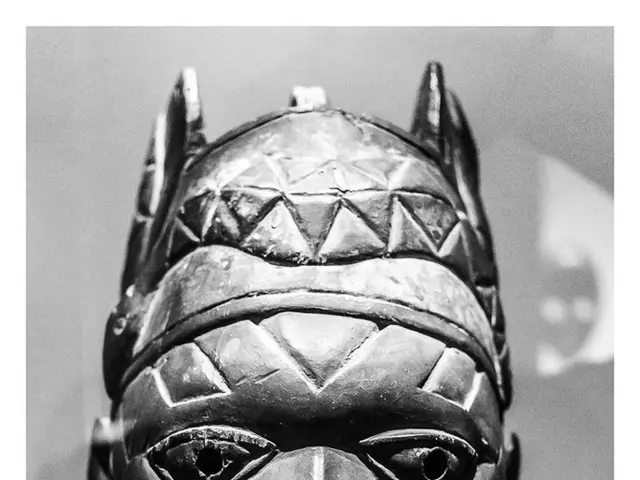Distinguishing Age Spots from Skin Cancer: Recognizing the Varieties for Proper Identification
Rewritten Article:
Skin discolorations known as age spots can pop up as you get older, and they can look like certain types of skin cancer or precancerous growths. But fear not, my dear reader, as age spots are typically harmless and don't require treatment.
Both age spots and skin cancer love the sun, often appearing on areas commonly exposed to the sun's rays, like the hands, face, and shoulders. Recognizing the differences between these two conditions can help you identify when you may need to consult a healthcare professional. Let's delve into the nitty-gritty of age spots and skin cancer.
Age Spots vs. Skin Cancer: Let's Settle the Score
Age spots and skin cancer can share some resemblance, but they've got some key differences that set them apart.
Age Spots (A.K.A Sunspots or Liver Spots):- These small patches of skin are generally darker than their surrounding area.- They're usually flat, smooth, and non-itchy.- Age spots develop when the body produces excess melanin to protect the skin from UV radiation.- They're more common in lighter skin tones but can appear on any skin color.- Typically, age spots make their debut in middle age and beyond.
Skin Cancer:- Skin cancer is no joke. It's essential to recognize the warning signs.- Skin cancer can appear in sun-exposed areas since UV radiation can cause damage to skin cells, leading to cell mutation and accelerated growth.- The three main types of skin cancer are basal cell carcinoma, squamous cell carcinoma, and melanoma.- Actinic keratosis, a precancerous growth, may also be mistaken for age spots.
Got a Spot? Look Twice!
Can age spots change into cancer? Well, age spots themselves don't transform into cancer, but actinic keratosis, which might look similar, is a precancerous growth that could potentially turn into skin cancer if left untreated. Keep a close eye on any new or changing marks on your skin, and consult a healthcare professional if you notice any symptoms.
Symptoms: Age Spots vs. Skin Cancer Side-by-Side
Here are some symptoms to help identify which condition you may be dealing with:
Age Spot Symptoms:
- Flat and smooth, often with clear boundaries.
- Yellow, brown, or gray in color, ranging in size from a few millimeters to several centimeters.
- They most commonly appear on sun-exposed areas like the face, hands, shoulders, feet, arms, and back.
- Age spots might fade during winter but become more prominent in summer.
Skin Cancer Symptoms:
- Skin cancer's symptoms can vary based on factors like the type of skin cancer.
- Signs of a cancerous growth include asymmetrical shape, irregular borders, changes in color, size, or shape, multiple colors, and various textures.
- Actinic keratosis tells-tale signs include red, gray, pink, or skin-colored patches, scaly patches that may look like age spots, and scalp, rough bumps that can resemble acne or horn-like growths.
When to Call the Big Boss (Your Doctor)
If you spot anything unusual on your skin, it's important to speak with a doctor. Early detection of skin cancer can make it easier to treat, so always keep an eye on your skin for any changes. Seek medical advice if a mark on your skin:
- Changes in color, shape, size, or location.
- Looks different from other marks on your skin.
- Itches, scabs over, or bleeds and doesn't heal within four weeks.
Diagnosis: A Professional Examination
A doctor or dermatologist can diagnose age spots and other skin conditions through a physical examination. By examining the spot's appearance, texture, and placement, they can determine whether it's likely to be an age spot or something else. If they're unsure, they might perform a skin biopsy to test for other conditions. The results of a skin biopsy help determine whether you have skin cancer, actinic keratosis, or another skin condition.
Treatment: Aging Gracefully or Tackling the Issue
Although age spots are harmless, they can be a cause for cosmetic concern for some people. Options for reducing age spots' appearance include using creams and lotions or opting for procedures like laser treatments, cryosurgery, microdermabrasion, or chemical peeling. A dermatologist can help advise on the treatments most likely to work for you.
When it comes to skin cancer, treatment options vary depending on factors like the type and stage of skin cancer. Surgical removal of basal cell and squamous cell carcinomas is ideal when possible. Other treatment options for skin cancer and actinic keratosis include topical therapies, radiation therapy, chemotherapy, immunotherapy, and systemic medication. Early detection of skin cancer significantly improves the likelihood of a successful treatment outcome, especially for melanoma.
- Age spots, often called sunspots or liver spots, are harmless and typically appear on older individuals, usually in middle age and beyond.
- Both age spots and skin cancer are common in areas exposed to the sun's rays, such as the hands, face, and shoulders, making it essential to differentiate between the two.
- Age spots are flat, smooth, and non-itchy, while skin cancer can display irregular borders, changes in color, size, or shape, and various textures.
- Actinic keratosis, a precancerous growth, can resemble age spots but may potentially develop into skin cancer if left untreated.
- A doctor or dermatologist can examine skin conditions through a physical evaluation, observing the spot's appearance, texture, and placement to diagnose age spots or other skin conditions.
- Skin biopsies can help determine if a spot is skin cancer, actinic keratosis, or another skin condition, as they test the cells and tissue beneath the skin's surface.
- Early detection of skin cancer can increase the likelihood of successful treatment, so consult a healthcare professional if you notice any changes, itching, scabbing, or bleeding on your skin that doesn't heal within four weeks.
- Healthcare professionals can advise on skin-care options for cosmetic concerns related to age spots, such as using creams or undergoing laser treatments, cryosurgery, microdermabrasion, or chemical peeling. Treatment options for skin cancer depend on factors like the type and stage of cancer, with options ranging from topical therapies to surgery, radiation therapy, chemotherapy, immunotherapy, and systemic medication.







